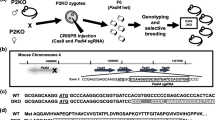Summary
We asked whether a movement disorder could be elicited by deprivation of pantothenic acid (PA; vitamin B5), the substrate for the enzyme pantothenate kinase 2 (PANK2), which is deficient in the inherited neurological disorder PKAN (pantothenate kinase-associated neurodegeneration formerly called Hallervorden–Spatz syndrome). This study was undertaken because mice made null for Pank2 failed to show the neurological manifestations of the human disease. Wild-type and Pank2 mutant mice were fed pantothenic acid-deficient diets and were monitored for general health, fertility and movement compared with animals on control diets over time. Mice of both genotypes on PA-deficient diets exhibited poor grooming, greying of fur and decreased body weight. With PA deprivation, wild-type mice manifested azoospermia (a phenotype also seen in Pank2 mice) as well as a movement disorder with a low-lying pelvis and slow steps. Rear limbs appeared to drag and occasionally extended into unnatural postures for 16–17s duration, possibly indicative of dystonia. Movement disruption probably also occurs in PA-deprived Pank2 mutant mice, but they died precipitously before undergoing detailed analysis. Remarkably, restoration of dietary PA led to recovery of general health and grooming, weight gain, reversal of the movement disorder, and reappearance of mature sperm within 4 weeks. This study confirms the primacy of PA metabolism in the mechanism of disease in PKAN. PA deprivation provides a useful phenocopy for PKAN and allows us to test pharmacological and other interventional strategies in the treatment of this devastating disease.
Similar content being viewed by others
Abbreviations
- PA:
-
pantothenic acid
- PANK2:
-
pantothenate kinase 2
- PKAN:
-
pantothenate kinase-associated neurodegeneration
References
Barlow C, Hirotsune S, Paylor R, et al (1999) Atm-deficient mice: a paradigm of ataxia telangiectasia. Cell 86(1): 159–171.
Buchner DA, Trudeau M, Meisler MH (2003) SCNM1, a putative RNA splicing factor that modifies disease severity in mice. Science 301(5635): 967–969.
Carter RJ, Lione LA, Humby T, et al (1999) Characterization of progressive motor deficits in mice transgenic for the human Huntington’s disease mutation. J.Neurosci 19(8): 3248–3257.
Clothier B, Robinson S, Akhtar RA, et al (2000) Genetic variation of basal iron status, ferritin and iron regulatory protein in mice: potential for modulation of oxidative stress. Biochem Pharmacol 59(2): 115–122.
Crawley JN (2000) What’s Wrong With My Mouse? In: Behavioral Phenotyping of Transgenic and Knockout Mice. New York: Wiley-Liss, 31–45, 47–63.
Crawley JN, Paylor R (1997) A proposed test battery and constellations of specific behavioral paradigms to investigate the behavioral phenotypes of transgenic and knockout mice. Horm Behav 31(3): 197–211.
Dooling EC, Schoene WC, Richardson EP Jr (1974) Hallervorden–Spatz syndrome. Arch Neurol 30: 70–83.
Fleming RE, Holden CC, Tomatsu S, et al (2001) Mouse strain differences determine severity of iron accumulation in Hfe knockout model of hereditary hemochromatosis. Proc Natl Acad Sci USA 98(5): 2707–2711.
Hayflick SJ, Westaway SK, Levinson B, et al (2003) Genetic, clinical, and radiographic delineation of Hallervorden–Spatz syndrome. N Engl J Med 348: 33–40.
Hortnagel K, Prokisch H, Meitinger T (2003) An isoform of hPANK2, deficient in pantothenate kinase-associated neurodegeneration, localizes to mitochondria. Hum Mol Genet 12: 321–327.
Johnson MA, Kuo YM, Westaway SK, et al (2004) Mitochondrial localization of human PANK2 and hypotheses of secondary iron accumulation in pantothenate kinase-associated neurodegeneration. Ann NY Acad Sci 1012: 282–298.
Kuo YM, Gitschier J, Packman S (1997) Developmental expression of the mouse mottled and toxic milk genes suggests distinct functions for the Menkes and Wilson disease copper transporters. Hum Mol Genet 6: 1043–1049.
Kuo YM, Duncan JL, Westaway SK, et al (2005) Deficiency of pantothenate kinase 2 (Pank2) in mice leads to retinal degeneration and azoospermia. Hum Mol Genet 14: 49–57.
Leonardi R, Rock CO, Jackowski S, Zhang Y-M (2007) Activation of human mitochondrial pantothenate kinase 2 by palmitoylcarnitine. Proc Natl Acad Sci USA 104: 1494–1499.
McCall KB, Waisman HA, Elvehjem CA, et al (1946) A study of pyridoxine and pantothenic deficiencies in the monkey (Macaca mulatta). J Nutr 31: 685–697.
Nelson MM, Evans HM (1946) Pantothenic acid deficiency and reporoduction in the rat. J Nutr 31: 497–550.
Pekhletski R, Gerlai R, Overstreet LS, et al (1996) Impaired cerebellar synaptic plasticity and motor performance in mice lacking the mGluR4 subtype of metabotropic glutamate receptor. J. Neurosci 16: 6364–6473.
Plesofsky-Vig N (1996) Pantothenic acid. In: Ziegler EE and Filer LJ, eds. Present Knowledge in Nutrition, 7th edn. Washington DC: ILSI Press, 237–244.
Sheppard AJ, Johnson BC (1957) Pantothenic acid deficiency in the growing calf. J Nutr 61: 195–205.
Ullrey DE, Becker DE, Terrill SW, et al (1955) Dietary levels of pantothenic acid and reproductive performance of female swine. J Nutr 57: 410–414.
Wintrobe MM, Follis RH Jr, Alcayaga R, et al (1943) Pantothenic acid deficiency in swine. Bull John Hopkins Hosp 73: 313–342.
Zhang Y-M, Rock CO, Jackowski S (2006) Biochemical properties of human pantothenate kinase 2 isoforms and mutations linked to pantothenate kinase-associated neurodegeneration. J Biol Chem 281: 107–114.
Zhou B, Westaway SK, Levinson B, et al (2001) A novel pantothenate kinase gene (PANK2) is defective in Hallervorden–Spatz syndrome. Nat Genet 28: 345–349.
Author information
Authors and Affiliations
Corresponding author
Additional information
Communicating editor: Michael Gibson
Competing interests: None declared
References to electronic databases. OMIM: PKAN 234200, 606157. Genbank: PANK2 NM_153638; Pank2 NM_153501 Pank2. Pantothenate kinase EC 2.7.1.33
Rights and permissions
About this article
Cite this article
Kuo, Y.M., Hayflick, S.J. & Gitschier, J. Deprivation of pantothenic acid elicits a movement disorder and azoospermia in a mouse model of pantothenate kinase-associated neurodegeneration. J Inherit Metab Dis 30, 310–317 (2007). https://doi.org/10.1007/s10545-007-0560-8
Received:
Revised:
Accepted:
Published:
Issue Date:
DOI: https://doi.org/10.1007/s10545-007-0560-8




